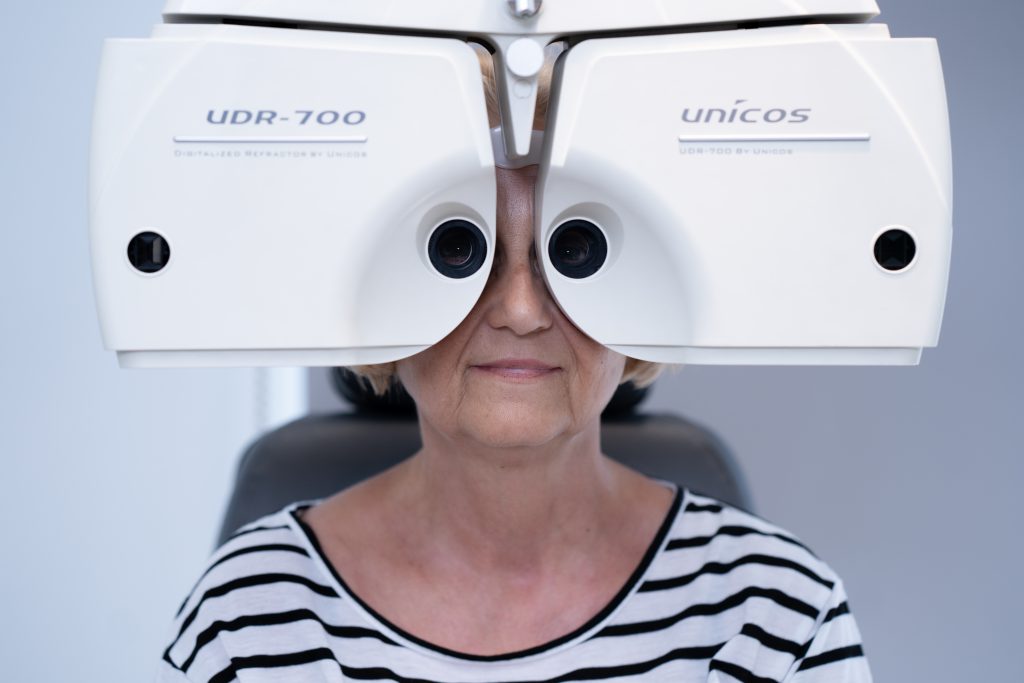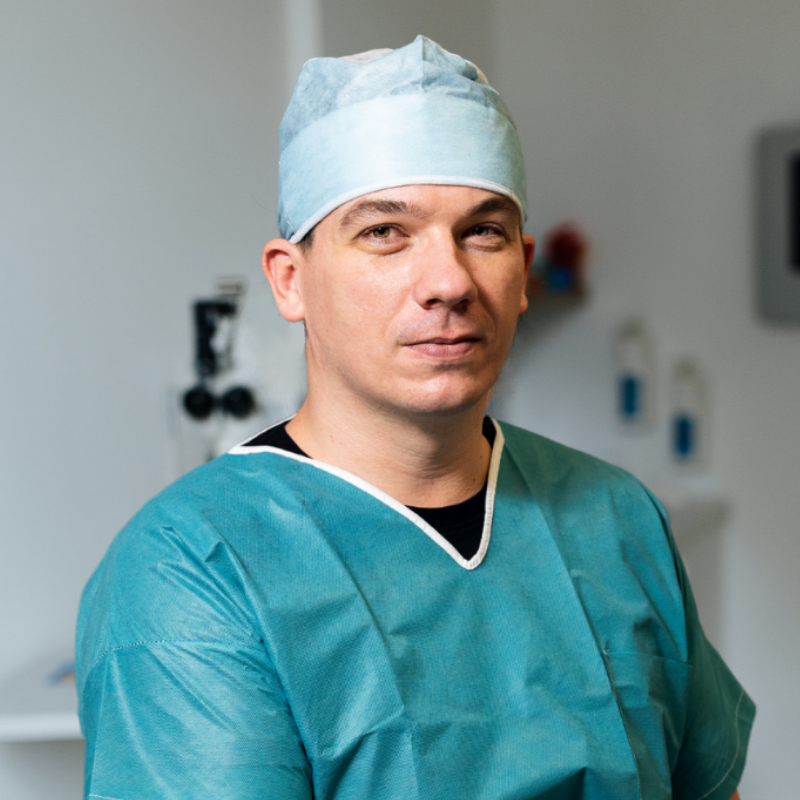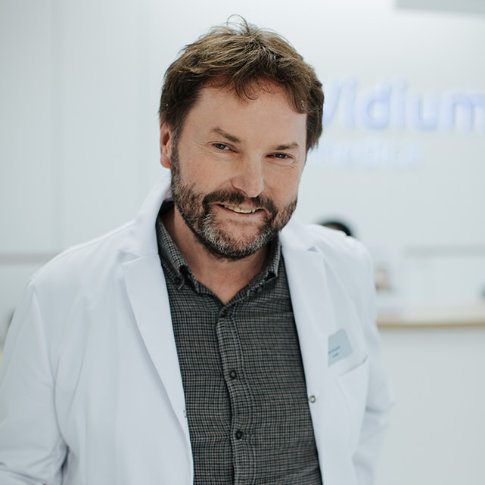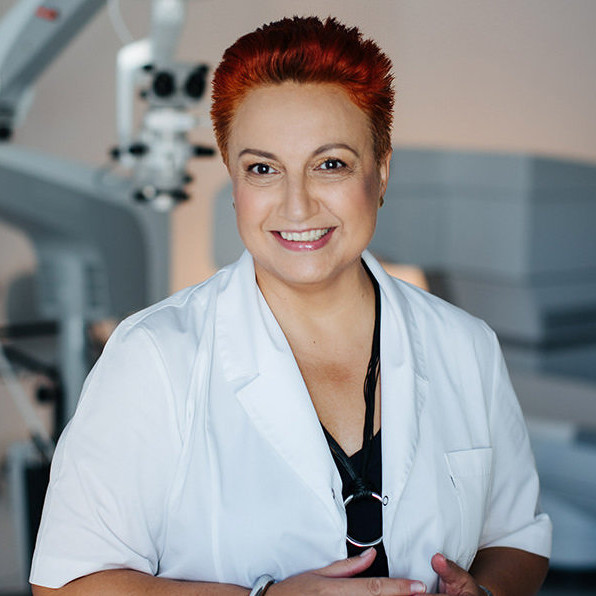Operacja zaćmy – usuwanie zaćmy laserem
Najczęściej wykonywana procedura medyczna na świecie
Rozbudowany pakiet badań przed zabiegiem
Indywidualnie dopasowane do potrzeb Pacjenta specjalistyczne implanty wewnątrzgałkowe
Szybki i bezbolesny zabieg
Wsparcie wszczepu nowoczesnym systemem VERION
Innowacyjne soczewki zwiększonej głębi ostrości i szerokim zakresie widzenia – AcrySoft® IQ Vivity ™

Co to jest zaćma?
Zaćma to postępujący proces zmętnienia soczewki oka, który jest naturalnym zjawiskiem związanym ze starzeniem się organizmu. Schorzenie to dotyka wszystkich ludzi, choć tempo jego rozwoju może się różnić w zależności od indywidualnych czynników. Podstawową funkcją soczewki jest tworzenie ostrego obrazu na dnie oka, jednak w miarę postępu zaćmy traci ona swoją kluczową cechę – przejrzystość.
To stopniowe zmętnienie prowadzi do pogorszenia jakości widzenia, uniemożliwiając ostre odwzorowanie obrazu na siatkówce. Proces ten może trwać latami, a pierwsze objawy są często zauważalne dopiero wtedy, gdy pogarszający się wzrok zaczyna znacząco wpływać na codzienne funkcjonowanie. Zaćma jest schorzeniem, które leczy się wyłącznie operacyjnie, a nieleczona może prowadzić nawet do całkowitej utraty wzroku, będąc najczęstszą przyczyną ślepoty na świecie.
Warto podkreślić, że zaćma nie jest wyłącznie domeną osób starszych. Może występować również u młodszych pacjentów, szczególnie tych zmagających się z krótkowzrocznością lub cukrzycą. Ponadto, zaćma może mieć charakter nabyty, wrodzony lub pourazowy, a w niektórych przypadkach może być związana z wykonywanym zawodem (np. „zaćma spawacza”).
Na czym polega operacja zaćmy?
Operacja zaćmy to zaawansowany zabieg chirurgiczny, którego celem jest usunięcie zmętniałej soczewki oka i zastąpienie jej sztucznym implantem. Procedura ta, zwana fakoemulsyfikacją, polega na rozdrobnieniu zmętniałej soczewki przy użyciu ultradźwięków, a następnie odessaniu jej fragmentów. Zabieg przeprowadzany jest w znieczuleniu miejscowym. Po usunięciu naturalnej soczewki, chirurg wszczepia sztuczną soczewkę wewnątrzgałkową, która przywraca ostrość widzenia
Ile trwa operacja zaćmy?
Operacja zaćmy trwa około 15 – 30 minut i Pacjent tego samego dnia wraca do domu.
| Soczewka | widzenie do dali | widzenie do bliży | widzenie do odległości pośrednich | korekcja astygmatyzmu |
|---|---|---|---|---|
| jednoogniskowa | ✓ | |||
| jednoogniskowa toryczna | ✓ | ✓ | ||
| wieloogniskowa | ✓ | ✓ | ✓ | |
| wieloogniskowa toryczna | ✓ | ✓ | ✓ | ✓ |
| o przedłużonej głębi ostrości | ✓ | widzenie funkcjonalne | ✓ | |
| o przedłużonej głębi ostrości toryczna | ✓ | widzenie funkcjonalne | ✓ | ✓ |
Operacja zaćmy to wszczepienie implantu. Wykonywane jest raz na całe życie. Od właściwego wyboru soczewki i miejsca operacji zależy jakość widzenia.
PRZEMYŚLANY WYBÓR JEST NAJWAŻNIEJSZY
Objawy zaćmy
Pierwsze objawy mogą być niedostrzegalne lub bardzo słabe. Zmętnieniu soczewki nie towarzyszą bowiem ani ból, ani nawet przekrwienie oka. Choroba daje o sobie znać różnymi zaburzeniami wzroku, które zależą od umiejscowienia zmętnień. Dlatego każde zauważalne pogorszenie się widzenia, np. brak ostrości lub rozmyty obraz, powinno być znakiem ostrzegawczym. W takim wypadku niezwłocznie należy zgłosić się do specjalisty, który oceni przyczynę dolegliwości.


Droga pacjenta
Droga pacjenta zaczyna się od umówienia wizyty w naszej klinice. Celem wizyty kwalifikacyjnej jest kompleksowe badanie Pacjenta i dobór optymalnej soczewki. Na badanie do zabiegu usunięcia zaćmy należy przeznaczyć około 1 – 3 godzin. Wizyta rozpoczyna się od wywiadu medycznego i wypełnienia ankiety medycznej. Jeżeli Pacjent ma wcześniej wykonane badania to zachęcamy do przyniesienia ich na wizytę kwalifikacyjną.
Jaką soczewkę wybrać?
Obecnie chirurdzy okulistyczni oraz Pacjenci mają do wyboru szeroką gamę sztucznych soczewek wewnątrzgałkowych, przeznaczonych do wszczepienia w miejsce zmętniałej soczewki. Poszczególne modele różnią się od siebie kształtem oraz materiałem, z którego są wyprodukowane.


Rodzaje soczewek
Wraz z rozwojem cywilizacji wzrastają potrzeby Pacjentów oraz ich wymagania dotyczące jakości życia i ostrości wzroku po operacji zaćmy, najlepiej bez konieczności używania dodatkowych okularów. Implanty soczewkowe stosowane w chirurgii zaćmy można podzielić na standardowe i soczewki z grupy Premium.
Jak przebiega operacja zaćmy?
Jedyną metodą leczenia zaćmy, jest poddanie się zabiegowi usunięcia zmętniałej soczewki i zastąpieniu jej nowoczesnym implantem. Podczas zabiegu, za pomocą ultradźwięków, rozbija się zmętniałą soczewkę, która następnie jest usuwana a na jej miejsce wszczepiana jest nowa. Metoda ta znana jest jako fakoemulsyfikacja. W trakcie zabiegu, pacjent jest w stałym kontakcie z lekarzem operatorem oraz pozostałym personelem medycznym. Dzięki znieczuleniu miejscowemu w postaci kropli Zabieg jest całkowicie bezbolesny a pacjent niemal od razu po jego zakończeniu może samodzielnie udać się do domu.


Przyczyny zaćmy
Zaćma najczęściej pojawia się u osób po 55 roku życia. Może również występować u ludzi młodych. W przypadku osób w podeszłym wieku, zaćma jest naturalnym objawem starzenia się organizmu. Z wiekiem zmienia się metabolizm i występują zaburzenia równowagi biochemicznej i osmotycznej, co nie pozwala na zachowanie przejrzystości soczewki.
Jak uniknąć zaćmy?
Rozsądna i efektywna ochrona przed zaćmą starczą polega na stosowaniu zasad profilaktyki ogólnoustrojowej.


Najczęstsze pytania
Czy wykonujemy zabiegi refundowane na NFZ? Czy oferujemy nocleg dla przyjezdnych? Czy możliwe jest całkowite wyleczenie zaćmy? Zajrzyj do naszego działu z najczęstszymi pytaniami od pacjentów, aby dowiedzieć się więcej na temat leczenia oraz zabiegów usuwania zaćmy w klinice Optegra (dawniej Vidium Medica).

Usuwanie zaćmy
Cena badań kwalifikacyjnych
399 zł
Cena zabiegu
od 3000 zł
Lekarze operujący zaćmę
Zaćma – najczęściej zadawane pytania (FAQ)
Czy warto przeprowadzić operację zaćmy?
Przeprowadzenie operacji zaćmy jest zdecydowanie zalecane, gdyż jest to jedyna skuteczna metoda leczenia tego schorzenia, pozwalająca na przywrócenie ostrości widzenia i poprawę jakości życia pacjenta. Zabieg ten, wykonywany przez doświadczonych chirurgów okulistów, charakteryzuje się wysokim poziomem bezpieczeństwa i efektywności, a nowoczesne techniki operacyjne umożliwiają szybką rekonwalescencję. Należy podkreślić, że nieleczona zaćma może prowadzić do poważnych konsekwencji, włącznie z całkowitą utratą wzroku.
Kto kwalifikuje się do operacji zaćmy?
Do operacji zaćmy kwalifikują się pacjenci, u których zmętnienie soczewki oka znacząco wpływa na jakość widzenia i codzienne funkcjonowanie. Leczenie zaćmy poprzez zabieg chirurgiczny jest zalecane, gdy ostrość wzroku spada poniżej 0.6 (z najlepszą korekcją) lub gdy zaćma utrudnia diagnostykę i leczenie innych schorzeń oka. Usuwanie zaćmy może być również wskazane w przypadkach jaskry zamkniętego kąta lub gdy powstaje znaczna różnowzroczność po operacji pierwszego oka.
Kiedy najlepiej wykonać operację zaćmy?
Decyzja o przeprowadzeniu operacji zaćmy powinna być podjęta, gdy schorzenie to zaczyna znacząco wpływać na jakość życia pacjenta. Zabieg usunięcia zaćmy jest zalecany w momencie, gdy pogorszenie ostrości wzroku utrudnia wykonywanie codziennych czynności, takich jak czytanie, prowadzenie samochodu czy oglądanie telewizji. Wbrew powszechnemu przekonaniu, nie ma potrzeby czekać, aż zaćma “dojrzeje” – jest to przestarzały pogląd, który może prowadzić do niepotrzebnego opóźnienia leczenia. Współczesna okulistyka zaleca przeprowadzenie operacji zaćmy na wcześniejszym etapie rozwoju schorzenia, co nie tylko ułatwia sam zabieg, ale także przyspiesza proces rekonwalescencji i zmniejsza ryzyko powikłań.
W jakim wieku można operować zaćmę?
Operacja zaćmy może być przeprowadzona w każdym wieku, gdyż nie istnieje górna granica wiekowa dla tego zabiegu. Współczesne metody usuwania zaćmy są na tyle bezpieczne i efektywne, że umożliwiają wykonywanie operacji nawet u pacjentów w bardzo zaawansowanym wieku. Warto podkreślić, że zabiegi u osób po 90. roku życia są obecnie powszechnie wykonywane, a statystyki pokazują bardzo dobre rezultaty tych operacji.
Czy zabieg operacji zaćmy jest poważny?
Operacja zaćmy, mimo że jest zabiegiem chirurgicznym, nie jest uznawana za poważną procedurę medyczną. Zabieg usunięcia zaćmy trwa zazwyczaj od 15 do 30 minut, co świadczy o jego relatywnie niskiej inwazyjności i zaawansowaniu technik operacyjnych. Co istotne, pacjent poddający się operacji zaćmy może wrócić do domu tego samego dnia, co znacząco skraca okres hospitalizacji i przyspiesza powrót do codziennych aktywności. Nowoczesne metody leczenia zaćmy, w tym operacje laserowe, charakteryzują się wysokim poziomem bezpieczeństwa i skuteczności, minimalizując ryzyko powikłań i skracając czas rekonwalescencji.
Jak przebiega operacja zaćmy?
Operacja zaćmy to precyzyjny zabieg chirurgiczny, który zazwyczaj trwa od 15 do 30 minut i jest wykonywany w znieczuleniu miejscowym. Podczas zabiegu usunięcia zaćmy chirurg wykonuje niewielkie nacięcie w oku (około 2-3 mm), przez które wprowadza narzędzie wykorzystujące ultradźwięki do rozbicia zmętniałej soczewki na mniejsze fragmenty, które następnie są usuwane. Na miejsce usuniętej naturalnej soczewki implantowana jest sztuczna soczewka wewnątrzgałkowa, co przywraca pacjentowi ostrość widzenia
Jak długo trwa pobyt w placówce po operacji zaćmy?
Operacja zaćmy jest obecnie zabiegiem ambulatoryjnym, co oznacza, że pacjent wraca do domu tego samego dnia, w którym przeprowadzono zabieg. Zazwyczaj pobyt w placówce medycznej po usunięciu zaćmy trwa kilka godzin, podczas których personel medyczny monitoruje stan pacjenta i upewnia się, że nie wystąpiły żadne bezpośrednie powikłania. Po tym krótkim okresie obserwacji i otrzymaniu szczegółowych zaleceń pooperacyjnych, pacjent może bezpiecznie opuścić klinikę i kontynuować rekonwalescencję w domowym zaciszu
Jak długo goi się oko po operacji zaćmy?
Proces gojenia oka po operacji zaćmy jest indywidualny, ale zazwyczaj trwa od kilku dni do kilku tygodni. Większość pacjentów odczuwa znaczną poprawę widzenia już w ciągu pierwszych 24-48 godzin po zabiegu, jednak pełna stabilizacja wzroku i całkowite wygojenie oka może nastąpić w okresie od 4 do 6 tygodni po operacyjnym leczeniu zaćmy.
Czego nie wolno robić po operacji zaćmy?
Po operacji zaćmy pacjent powinien przestrzegać kilku istotnych zaleceń, aby zapewnić prawidłowe gojenie i uniknąć powikłań. Przede wszystkim, w pierwszych tygodniach po zabiegu należy unikać pocierania oczu, schylania się i podnoszenia ciężkich przedmiotów, gdyż może to zwiększyć ciśnienie wewnątrzgałkowe i uszkodzić operowane oko. Ważne jest również, aby przez około miesiąc po operacji zaćmy nie dopuścić do kontaktu oka z wodą zawierającą detergenty, co oznacza rezygnację z pływania, korzystania z sauny czy hydromasażu. Ponadto, pacjent powinien ograniczyć intensywny wysiłek fizyczny, w tym uprawianie sportów, oraz unikać przebywania w zapylonym środowisku przez okres rekonwalescencji, który zazwyczaj trwa od 4 do 6 tygodni.
Ile prywatnie kosztuje zabieg na zaćmę?
W naszych klinikach oferujemy kompleksową usługę usuwania zaćmy w konkurencyjnych cenach. Badania kwalifikacyjne, które są niezbędne do przeprowadzenia zabiegu, kosztują 399 zł. Sam zabieg usunięcia zaćmy kosztuje od 3000 zł, przy czym dokładna cena może się różnić w zależności od indywidualnych potrzeb pacjenta i wybranej metody operacyjnej. Rozumiemy, że operacja zaćmy może stanowić znaczący wydatek, więc oferujemy elastyczne opcje finansowania. Pacjenci mają możliwość rozłożenia kosztu zabiegu nawet na 50 rat.



